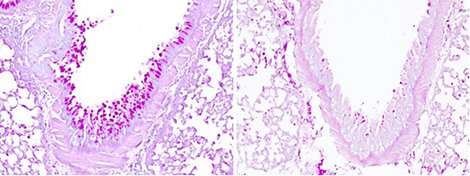Excessive mucus production is characteristic of allergic asthma. The IL-33 protein, a major factor predisposing humans to asthma, detects allergen protease activity. Activated by proteases, IL-33 sets off a cascade of reactions, including mucus production, that are associated with asthma and other allergic diseases. When IL-33 activation is inhibited (see image on right), these reactions are not triggered. Credit: Corinne Cayrol and Jean-Philippe Girard, IPBS, CNRS / Université Toulouse III--Paul Sabatier
A team of Inserm and CNRS researchers from the Institute of Pharmacology and Structural Biology have identified a protein that acts like a sensor detecting allergens in the respiratory tract that are responsible for asthma attacks. Their study, co-directed by Corinne Cayrol and Jean-Philippe Girard, is published in Nature Immunology. The work offers hope for breakthroughs in the treatment of allergic diseases.
What do mold, pollen, and cockroaches have in common? Though they correspond to three different kingdoms of life, they can all cause asthma attacks in susceptible people. And all of them, despite their very different compositions, contain enzymes called proteases.
The IPBS team has identified a human protein that reacts to environmental allergens: interleukin-33 (IL-33). When allergens enter the human respiratory tract, they release proteases that hack IL-33 molecules into extremely reactive pieces, triggering the chain reactions behind allergy symptoms.
Apparently, the same mechanism is responsible for these reactions after exposure to any of several allergens. IL-33 was shown to detect 14 different allergens tested, which include some present in ambient air (i.e. pollen, house dust mites, and fungal spores) and others associated with occupational asthma (like subtilisin, found in detergents).
These findings are important because they establish a direct link between genetics and the environment. Indeed, the gene that codes for IL-33 is among the principal ones predisposing humans to asthma. Furthermore, clinical trials now underway are targeting IL-33. Inhibiting production of reactive IL-33 fragments after allergen exposure might make it possible to limit severe allergic reactions in asthmatic patients.
More information: Corinne Cayrol et al, Environmental allergens induce allergic inflammation through proteolytic maturation of IL-33, Nature Immunology (2018). DOI: 10.1038/s41590-018-0067-5
Journal information: Nature Immunology
Provided by CNRS






















